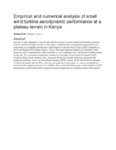| dc.description.abstract | Kenya's energy depends on fossil fuels and the country is yet to embrace alternative sources
that are environmentally friendly. In this paper, empirical and computational approaches are
presented to investigate aerodynamic performance of Small Wind Turbine (SWT) operation at
arid rural Mwingi-Kitui plateau region, Kenya. We used empirical statistics to represent wind
resource, and Computational Fluid Dynamics (CFD) to address SWT aerodynamic performance
at the site. The numerical simulations, employing Transition Shear Stress Transport (SST)
model and fully mesh resolved rotor, were performed and results obtained compared with
empirical methods. From the Wind Power Density (WPD) values, 44.50–85.48 W/m2 between
turbine hub heights 20 and 60 m, the site corresponds to wind class ≈1; hence unsuitable for
grid-connected power generation. In addition, the numerical findings give useful insights to SWT
aerodynamic performance with respect to empirical approach at a plateau terrain wind regime. | en_US |

